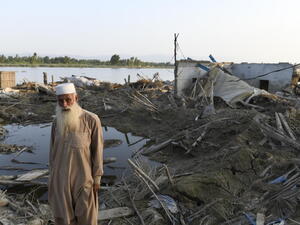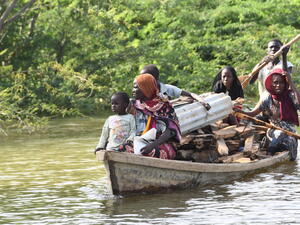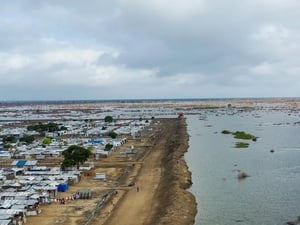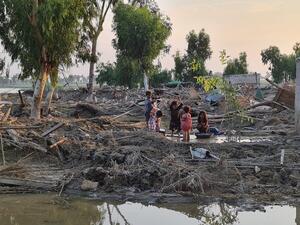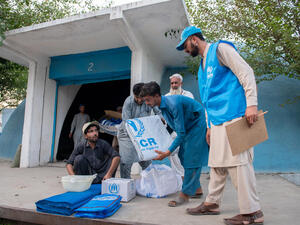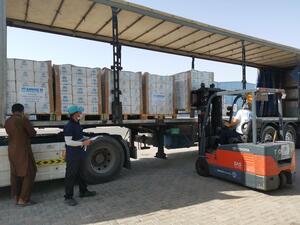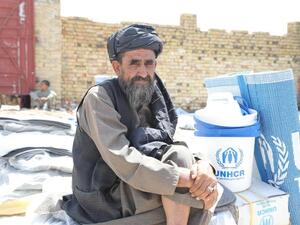Kenya flooding: Relief supplies delivered
Kenya flooding: Relief supplies delivered
UNHCR's emergency airlift to tens of thousands of refugees and surrounding communities in flood-stricken northern Kenya has delivered five planeloads of relief supplies since Sunday. We've also started a relocation movement by truck, donkey cart and on foot to help thousands of people move from flooded refugee camps to drier ground.
Water levels have dropped in the sprawling Dadaab refugee camps since the last flash flood on Saturday, when UNHCR staff said water levels rose by up to half a metre in just an hour. However, more houses have collapsed in Dagahaley - one of three camps that make up the Dadaab complex - due to continuing heavy rains.
With the drop in water levels, emergency aid teams are again able to reach the worst-hit camps - Dagahaley and Ifo. This has allowed UNHCR, CARE and other agencies to begin a relocation operation moving the most affected refugees from Ifo to Hagadera camp, 20 km away. Refugees wanting to go to Hagadera are gathering at assembly points in Ifo camp. Because of the difficulty of road transport in the flooded region, able-bodied men are being encouraged to walk to Hagadera, while most women and children are carried by truck. Thirty-two donkey carts carrying baggage are being used to accompany those making the 20-km journey on foot.
By last night, 2,000 refugees from Ifo had arrived in Hagadera and were given accommodation in new shelter blocks prepared earlier for the recent refugee influx from Somali that has now been brought to a halt by the rains. About 250 people were still waiting at the Ifo field office last evening awaiting transport and more are expected to make the journey over the next few days. Megaphones are being used to inform the camp population of the relocation operation. A way station to provide water, high energy biscuits and medical assistance has also been established on the Hagadera road. Meetings were also held with local authorities in Hagadera to brief them on the transfer of some refugees there - at least temporarily.
Aid supplies brought in on UNHCR's airlift are now being distributed. On Sunday, a chartered twin-engine DeHavilland C-8 Buffalo cargo aircraft made three flights from Nairobi to Dadaab, delivering 2,500 plastic sheets, 28 emergency health kits and 4,400 litres of aviation fuel. The aircraft made a further two flights yesterday (Monday), offloading 10,000 litres of diesel fuel and 200 shovels, which will be used to fill sandbags. We are looking for additional small cargo planes for the Dadaab airlift.
Plastic sheets will help refugees rebuild their shelters, while the sandbags will be used to shore up flood defences in three refugee camps around the two Dadaab camps that have been badly affected by the floodwaters. The diesel will be used for vehicles and generators, which drive water pumps and provide power to offices, hospitals and clinics in the camps.
The airlift became necessary after floods cut the only road - and convoy supply route - linking Dadaab and Nairobi. The floods have displaced more than 100,000 of the estimated 160,000 mainly Somalian refugees in Dadaab's camps. Three deaths have been reported in the refugee camps since the onset of the floods, and three children went missing on Saturday.
Health and sanitation remain a serious concern. The general health of the population has deteriorated due to the conditions, lack of food and sleep and difficulty in accessing medical care. Latrines throughout the camps have been flooded, contaminating standing water and posing a serious health risk. Fever, diarrhoea, eye and skin infections are common. UNICEF and other agencies are bringing in vaccines and other supplies to combat the spread of disease.
In Ifo, the biggest camp hosting some 54,000 refugees, a hospital was almost completely flooded on Sunday. The patients had to be transferred to the only ward which was not affected. Three of UNHCR's 10 vehicles have been lost to flooding, along with other equipment.


